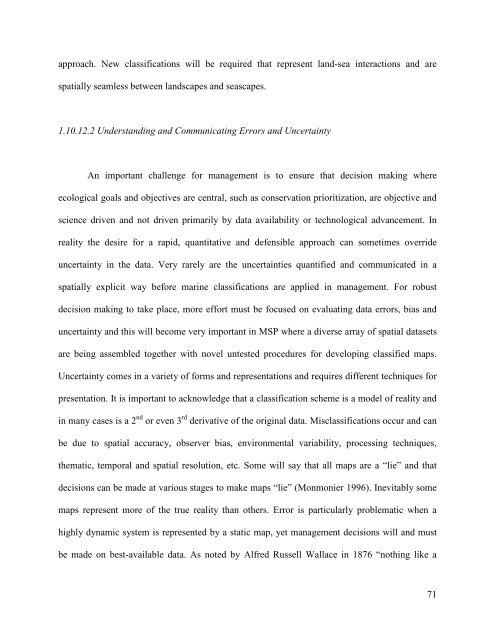1 1.10 Application of estuarine and coastal classifications in marine ...
1 1.10 Application of estuarine and coastal classifications in marine ...
1 1.10 Application of estuarine and coastal classifications in marine ...
You also want an ePaper? Increase the reach of your titles
YUMPU automatically turns print PDFs into web optimized ePapers that Google loves.
approach. New <strong>classifications</strong> will be required that represent l<strong>and</strong>-sea <strong>in</strong>teractions <strong>and</strong> are<br />
spatially seamless between l<strong>and</strong>scapes <strong>and</strong> seascapes.<br />
<strong>1.10</strong>.12.2 Underst<strong>and</strong><strong>in</strong>g <strong>and</strong> Communicat<strong>in</strong>g Errors <strong>and</strong> Uncerta<strong>in</strong>ty<br />
An important challenge for management is to ensure that decision mak<strong>in</strong>g where<br />
ecological goals <strong>and</strong> objectives are central, such as conservation prioritization, are objective <strong>and</strong><br />
science driven <strong>and</strong> not driven primarily by data availability or technological advancement. In<br />
reality the desire for a rapid, quantitative <strong>and</strong> defensible approach can sometimes override<br />
uncerta<strong>in</strong>ty <strong>in</strong> the data. Very rarely are the uncerta<strong>in</strong>ties quantified <strong>and</strong> communicated <strong>in</strong> a<br />
spatially explicit way before mar<strong>in</strong>e <strong>classifications</strong> are applied <strong>in</strong> management. For robust<br />
decision mak<strong>in</strong>g to take place, more effort must be focused on evaluat<strong>in</strong>g data errors, bias <strong>and</strong><br />
uncerta<strong>in</strong>ty <strong>and</strong> this will become very important <strong>in</strong> MSP where a diverse array <strong>of</strong> spatial datasets<br />
are be<strong>in</strong>g assembled together with novel untested procedures for develop<strong>in</strong>g classified maps.<br />
Uncerta<strong>in</strong>ty comes <strong>in</strong> a variety <strong>of</strong> forms <strong>and</strong> representations <strong>and</strong> requires different techniques for<br />
presentation. It is important to acknowledge that a classification scheme is a model <strong>of</strong> reality <strong>and</strong><br />
<strong>in</strong> many cases is a 2 nd or even 3 rd derivative <strong>of</strong> the orig<strong>in</strong>al data. Mis<strong>classifications</strong> occur <strong>and</strong> can<br />
be due to spatial accuracy, observer bias, environmental variability, process<strong>in</strong>g techniques,<br />
thematic, temporal <strong>and</strong> spatial resolution, etc. Some will say that all maps are a “lie” <strong>and</strong> that<br />
decisions can be made at various stages to make maps “lie” (Monmonier 1996). Inevitably some<br />
maps represent more <strong>of</strong> the true reality than others. Error is particularly problematic when a<br />
highly dynamic system is represented by a static map, yet management decisions will <strong>and</strong> must<br />
be made on best-available data. As noted by Alfred Russell Wallace <strong>in</strong> 1876 “noth<strong>in</strong>g like a<br />
71
















